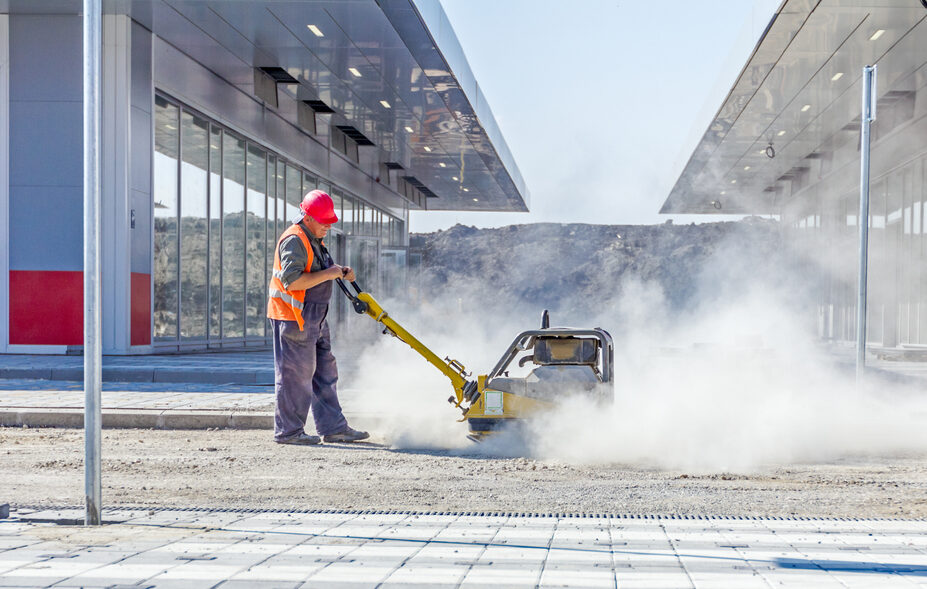
Construction Sites: Not Just Dirty and Dusty – Germy, Too
Germs are everywhere, including in dirt and dust!
When we think of dirt in our daily lives, we usually think of potted plants and gardens. When we think of dust, we think of the kind that we clean in our house and workplaces.
But fine dust can also be present at construction and maintenance projects inside a building, like taking out parts of a wall or renovating a room.
Also, when construction and maintenance projects that move a lot of dirt and dust around happen in or near a healthcare facility, it can send germs that are in the dirt and dust into the air.
These germs can harm certain patients with weakened immune systems.
What Kind of Germs Are in Dirt and Dust?
Dirt and dust contain many germs, including a fungus called Aspergillus.
Aspergillus and other fungi don’t usually make us sick. In fact, we all breathe them in every day.
But in some patients who don’t have a strong immune system, or whose lungs are damaged, Aspergillus can cause serious respiratory disease.
“A lot of patients have things going on that you can’t really see, like if their immune system is weak because of the medication for their cancer treatment,” said Dr. Abigail Carlson, an infectious diseases physician with the CDC, as part of CDC Project Firstline’s Inside Infection Control video series.
How to Prevent Dirt and Dust in Healthcare Settings
It is incredibly important to keep the healthcare environment clean and free of germs, especially if construction and maintenance projects are happening in or near healthcare facilities.
You can help reduce dust, dirt and germs in healthcare settings by cleaning and disinfecting surfaces and objects.
Cleaning removes dust, dirt, and germs from surfaces and objects, while disinfection destroys or kills germs.
Cleaning and disinfection are effective infection control actions that keep germs away from people and help keep germs from spreading.
It’s also important to maintain proper ventilation in the healthcare environment.
Good ventilation can help remove things from the air that we don’t want to breathe in, such as chemicals, dust, and germs.
One way to check if there’s ventilation in a room is to look for vents and fans.
However, always check with your building’s engineering or maintenance staff, or the people in your facility who oversee air handling and ventilation, before making changes to the ventilation in a room.
What Can You Do to Promote Infection Control in Your Healthcare Setting?
It is important to protect yourself, patients, and colleagues from germs that can spread from dirt and dust.
Remember to properly clean and disinfect objects and surfaces and maintain good ventilation in the healthcare setting.
If there are construction or maintenance projects happening in or near the building, make sure that the team takes the right steps to keep dust and dirt out of the air, like using barriers and sticky mats.
How else can you stay up to date on infection control actions?
Pledge to take a training module or activity from the CDC Project Firstline!
Access more information about infection prevention and control in healthcare by visiting resources from CDC Project Firstline.
Project Firstline creates resources, including videos and shareable images, web buttons, posters, and print materials. They also have facilitator toolkits to help workers lead trainings even if they are not an infection control expert.
Salud America! at UT Health San Antonio is working with the National Hispanic Medical Association to bring Project Firstline infection control educational content to healthcare workers, so they are equipped with the knowledge they need to protect themselves, their facilities, and their patients (Latinos and all communities) from infectious disease threats in healthcare settings.
You can read these articles:
- What is Project Firstline?
- What’s a Virus?
- How Do Viruses Make Us Sick?
- What is Ventilation and Why Does It Matter?
- What’s a Respiratory Droplet and Why Does It Matter?
- Why Do Cleaning and Disinfection Matter in Healthcare?
- We Need to Talk about Hand Hygiene Again
- What is the Goal of Infection Prevention and Control in Healthcare Settings?
- N95 Respirators: Everything You Need to Know
- How Do I Safely Use a Multi-Dose Vaccine Vial?
- Why are Gowns, Gloves, and Eye Protection Recommended for COVID-19?
“Healthcare teams in hospitals, nursing homes, and other care settings are the front lines against the spread of infection,” said Dr. Amelie G. Ramirez, director of Salud America! at UT Health San Antonio. “CDC’s Project Firstline is bolstering those efforts by developing evidence-based tools that can be delivered in a variety of ways to make infection control learning convenient and accessible for busy healthcare staff.”
Learn More about Project Firstline!
Editor’s Notes:
This article is part of a collaboration between Salud America!, the National Hispanic Medical Association, and the CDC’s Project Firstline. To find resources training materials, and other tools to bolster knowledge and practice of infection control, visit Project Firstline and view Salud America!’s infection control content.
The post Construction Sites: Not Just Dirty and Dusty – Germy, Too appeared first on Salud America.

